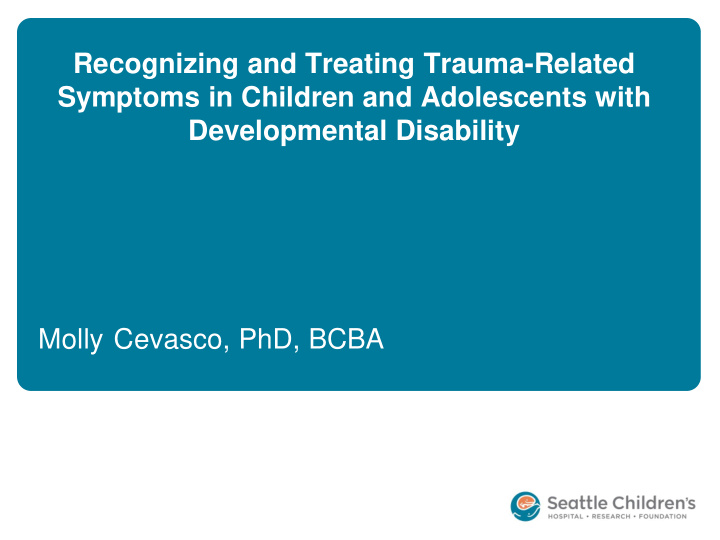



Recognizing and Treating Trauma-Related Symptoms in Children and Adolescents with Developmental Disability Molly Cevasco, PhD, BCBA
Introductions Who am I and how did I get here?
A gentle reminder
A little bit about you…
Objectives for tonight’s presentation • Participants will: • Learn about the prevalence of potentially traumatic experiences in individuals with developmental disabilities • Learn about diagnostic criteria for trauma-related disorders in children, with specific considerations for individuals with developmental disabilities • Identify and dispel common misconceptions about trauma • Learn about treatment approaches and steps caregivers can take to help address safety
How do we define trauma? “A traumatic event is a frightening, dangerous, or violent event that poses a threat to a child’s life or bodily integrity. Witnessing a traumatic event that threatens life or physical security of a loved one can also be traumatic.” National Child Traumatic Stress Network
Understanding the ACEs study • Adverse Childhood Experiences • Abuse • Neglect • Household Dysfunction • Experiencing adversity in childhood can be linked to later challenges with physical, social, and emotional wellbeing Fellitti, et al. 1998
Risk and protective factors for trauma-related symptoms • Potential Risk Factors • Interpersonal trauma (Copeland, Keeler & Angold, 2007) • Exposure to chronic adversity in childhood (Shonkoff et al. 2012) • Poly-victimization (Finkelhor, Omrod & Turner, 2007) • Thought suppression post-trauma (Trickey et al. 2012) • Unhelpful or inaccurate beliefs post-trauma (Hiller et al. 2019) • Limited social support and withdrawal (Trickey et al. 2012)
What’s the prevalence of trauma in children? Adverse Event Exposure by Age 16 32% 37% No exposure Exposure to 1 event Exposure to 9.1 victims of abuse 31% multiple events or neglect per 1000 (Copeland, Keeler & Angold, 2007)
Prevalence of trauma in children with developmental disabilities About 1 in 6 children ages 3 to 17 have a developmental disability Children with developmental disabilities have a rate of 10.1% to 24.7% rate of substantiated abuse claims
A deeper dive into IDD and abuse 10.1% ASD Only 16.5% ASD + ID 24.7% ID Only 8.8% Population Control McDonnell et al. 2019
What contributes to heightened rates of abuse? Socioeconomic Stress Involvement in Multiple Systems / Communication / Dependence on Social Delays others Parental Grief / Challenging Emotion Behaviors Dysregulation
Core components of trauma symptoms Intrusion Alterations Trauma Avoidance in Arousal Changes in Cognition
Diagnostic considerations for trauma and children with IDD • Limited verbal communication • Increased aggression and hyperactivity • Regression in development • Behavior that is developmentally incongruent (and not typical for that child) • Difficult peer relationships • Hopelessness • Delayed independence
Myths about children with IDD and trauma (NCTSN Trauma and IDD Toolkit) 1. Children with IDD cannot engage in treatment 2. Standard mental health treatment is ineffective for children with IDD 3. Behavior modification is the only option 4. Youth with intellectual disabilities do not experience trauma 5. Challenging behavior is always best explained by an intellectual disability 6. Children with IDD are protected from trauma because of their developmental age; they do not remember 7. Practitioners must have extensive experience treating people with IDD
Core concepts in treatment Education Safety Relaxation Planning Treatment Components Addressing Exposure mood and behavior Challenging beliefs and thoughts
Steps for caregivers • Teach and respect body rights • Ask children before engaging physically • Develop adaptive independence as much as possible • No Go Tell • Use accurate terminology • Reduce isolation • Share as openly with medical and mental health providers as you can • Recognize your own unhelpful thoughts and beliefs
Thank you! Molly Cevasco, PhD, BCBA - Molly.Cevasco@seattlechildrens.org
Recommend
More recommend